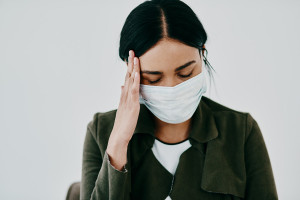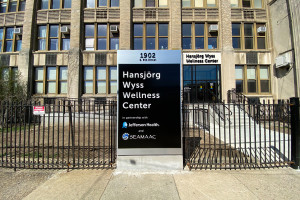5 Puzzling New Symptoms of Coronavirus, Explained
Philly health experts shed light on newly discovered symptoms and long-term effects of COVID-19.

Getty Images | Andrew Merry
It started with a cough. In the early days, when COVID-19 first began to spread beyond its origin in Wuhan, China, doctors warned about a pesky virus that was causing flu-like symptoms: fever, shortness of breath, a stubborn cough. Doctors have since learned that the virus affects different people in drastically different ways — some experience symptoms within a day or two of being exposed to the virus, others may not see symptoms for as many as two weeks, and some may carry and pass the virus to others without ever experiencing any symptoms at all. And the list of symptoms for COVID-19 has since expanded to include chills, muscle pain, headache, sore throat, and several newly discovered indicators that doctors are still trying to understand.
NextHealth PHL spoke with some of Philadelphia’s top medical experts and gathered the latest information about coronavirus symptoms and what they tell us about how the virus can affect the human body now and in the long term.
COVID-19 may begin with a loss of taste or smell
Among the many COVID-19 symptoms, we’ve recently learned about a sudden loss of taste or smell. Having these symptoms with a cold or flu is common and is often attributed to a blocked or stuffy nose. Danielle Reed, associate director of the Monell Chemical Senses Center, says COVID-19 is different because there is usually no nasal congestion.
According to Reed, people with colds and flu often think they have lost their sense of taste when they have only lost their sense of smell because so much of the flavor of food comes from its smell. However, in COVID-19, there is true taste and smell loss. Doctors are still trying to understand how and why it occurs.
“Our best theory, right now, is that a SARS-CoV-2 infection somehow shuts down the sensory cells in the nose and tongue,” Reed explained. “Consequently, whatever is happening to reduce the signal from the smell receptor cells in the nose to the brain is like what is happening to the taste cells on the tongue.”
Abrupt loss of smell, especially if the person has a fever (but not a stuffy or runny nose), is emerging as a classic trinity of COVID-19 symptoms and means the person should self-isolate and take all COVID-19 precautions. Reed says most people with COVID-19 will regain their sense of taste and smell, but some may not. Doctors don’t yet understand why some people get better, but others do not.
COVID-19 may cause blistering on the feet or “COVID Toes”
Tracking coronavirus symptoms has become an interdisciplinary task. In addition to the many physicians in critical care, pulmonology and emergency medicine already studying the disease, the arrival of a curious new symptom dubbed “COVID toes” has added dermatologists to the fold.
COVID-19 patients around the world have begun reporting the appearance of painful red blisters on their feet and, in some cases, their hand, too. The symptom reportedly resembles frostbite. Doctors are still trying to understand why a symptom that usually only occurs when people are exposed to extremely cold temperatures is now appearing in COVID-19 patients.
The American Academy of Dermatology Association has launched a COVID-19 dermatology registry to track the increasing numbers of instances of “COVID toes.” The registry is designed to enable health care professionals taking care of COVID-19 patients who develop dermatology related conditions to report what they’re seeing in one database so it can be shared with other researchers. The registry will also collect data for COVID-19 patients who have preexisting dermatology conditions and those who are taking dermatologic medications when they develop COVID-19.
“Our hope is that information you and others provide will help us understand dermatologic manifestations of the COVID-19 virus,” the registry creators said. “The success of this collaborative effort depends on active participation by our international health care community to obtain accurate and reliable information.”
The virus appears to attack the lungs worse than any other part of the body
A majority of COVID-19 symptoms are surfacing in the lungs. In addition to patients coming in for cough and shortness of breath, some patients are developing severe chest pain and even blood clots in their lungs. Daniel Salerno, director of the respiratory intensive care unit at Temple University Hospital, says the virus tends to attack the lungs drastically and fast.
“From the pulmonary perspective, we start to worry if patients start developing things like what we call pleuritic chest pain, which causes this intense pain in the chest because that could be pneumonia that is infecting your inner chest,” Salerno explained.
“One of the things we’ve seen is that sometimes when patients get pneumonia by itself, it goes bad very quickly. With COVID, we’ve seen people in the hospital that at one point they’re breathing what we call room air, they don’t need supplemental oxygen, and within 24 hours they’re intubated on 100 percent oxygen.”
Salerno says any sign of shortness of breath is a good reason to go to a healthcare provider for a coronavirus test, but some people have been buying fingertip pulse oximeters over the counter to monitor their oxygen levels on their own. Salerno warned against this DIY approach to monitoring COVID lung symptoms.
“I think that’s not necessarily a good thing because you’re going to feel short of breath before the number on an oximeter declines; it may encourage you to wait too long,” he said.
COVID-19 may also be responsible for multiple inflammatory and autoimmune conditions in adults and children
Health officials in New York City say a new inflammatory condition appearing in children between the ages of 2 and 15 may be tied to coronavirus. Doctors say children who have the syndrome are showing signs similar to those seen in patients with toxic shock syndrome or Kawasaki disease, an acute disorder that causes fever, rash, swelling of the hands and feet, and irritation and inflammation of the mouth, lips, and throat, among other symptoms.
According to Salerno, it is not uncommon for COVID-19 to send the immune system into overdrive.
“The way the virus works is fascinating because it seems like you have the infection by itself, at first, but some people get an autoimmune overreaction; some even get cytokine storms and other types of immune responses where the system is kind of overreacting,” he said. “It’s not the virus anymore, it’s your immune system that has gone a little bit crazy after the infection.”
This is when Salerno says medications for rheumatoid arthritis or lupus or other drugs that are used to calm the immune system can be effective for some patients who’ve been hospitalized for COVID-19.
In the long term, the virus can cause loss of motor functions
Broadway actor Nick Cordero is one of many patients who’ve experienced some of the most severe symptoms and after-effects of the virus. Cordero spent several weeks in a medically induced coma while being treated for COVID-19. He eventually developed a blood clot and had to have his right leg amputated. Cordero will have to undergo extensive physical therapy and rehabilitation, not only to learn how to adjust to walking with a newly amputated limb but to learn how to restore other motor functions.
One of Pennsylvania’s earliest coronavirus patients didn’t lose a leg but had to undergo substantial rehabilitation to learn how to walk, talk, eat and write again.


